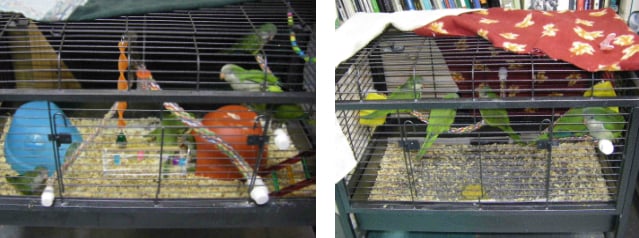Your cart is currently empty!

HARI Official Brand Site

An Education Process to Quality Companionship!
Who can resist the robust, “big parrot-trapped in a small body” personality of a Quaker? Also known as monk parakeets, Quaker Parrots are one of the most popular parrot species for companion lifestyle.
While the HARI flock includes many parrot species, the collection includes this ever popular companion species, the Quaker parrot. HARI Staff explains the “HARI way” on weaning and educating the owner so they are well adjusted for companion bird lifestyle.
At HARI, Quaker chicks are typically pulled from the nest at 2-3 weeks of age. A Chick Information File and Chick Growth Chart is set up for each baby. Health is assessed with a physical exam, initial weight monitoring, and logged into the chick’s file. And, it is this critical stage that Quaker chicks begin their “education” process! In the next coming weeks, the pupils are introduced to many skills such as towel training, technician handling that includes: grooming, observation of choanal papillae, behavior and more. But, their first lesson, and most critical for long healthy life, is the weaning process.
Initially, fledgling Quakers are housed in a brooder with clutchmates. To assimilate the sense of security of their nest box, the brooder is kept dark and covered. They will soon be ready to make a transition to their weaning cage.
Weaning cages should be well thought out with a very specific set up to make the weaning process as easy and as rapidly successful as possible. A weaning cage can also be the Night Cage for fledglings, as both should not have toys, only perches and food. For a nighttime cage, or “sleep cage” we recommend that toys should not be included to avoid hazardous accidents not to be discovered until the morning. Weaning cages, however, should not have toys for entirely different reasons. When fledglings are weaning their inquisitive minds need to be stimulated with food and nothing else as it is too easy for them to be distracted. Instead of toys the cage should contain several food bowls.

You can sometimes add a plastic or cardboard hut to give a hiding place to the Quakers, but this should be used with caution as they may become aggressive when provided with these shelters. We do suggest though that three sides of the cage be covered with blankets or towels during the day, and that all four sides should be covered at night. This will maintain focus and allow for the birds to sleep. Smaller cages are also better for weaning as it will help minimize distractions. We have had failures based on the size of some of the cages we have placed weaning birds into. A cage with too many toys or a variety of foods distracts the fledglings from the main focus of weaning onto a desired nutritional food, As the birds get older and are maintaining a proper weight they can then go in bigger cages, or Day Cage, where toys and foraging activities are encouraged.

We’re here to help you with everything bird-related! Discover more about parrot conservation, browse conferences and events in your area, connect with local bird clubs, locate a vet or parrot rescue nearby, and read up on fascinating avian news and articles.